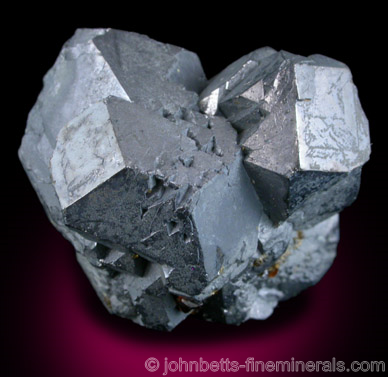The Mineral galena

Galena is the most common mineral containing lead, and has been well-known throughout the centuries. It is often well crystallized and forms in many interesting and distinct crystal shapes. Some cubic crystals have their edges cut by the partial octahedral growth, some octahedral crystals have their points flattened by cubic growth, and many crystals are found somewhat in-between cubic and octahedral. Dodecahedral growths may partially be found in octahedral or cubic-octahedral crystals, resulting in bizarre and interesting shapes.
Galena is a primary mineral. Most of the lead minerals, such as Cerussite and Anglesite are secondary minerals formed from Galena. Impurities in the structure of Galena, such as silver and bismuth, may change Galena's cleavage properties. Galena containing bismuth may exhibit octahedral cleavage, and silver in Galena may cause a specimen to exhibit flaky, slightly bent cleavage fragments.
Galena specimens may tarnish when exposed to air, becoming dull in luster. Freshly cleaved specimens exhibit a strong metallic luster, but over time the luster turns more dull, although still metallic. The tarnish can be removed by scrubbing the specimen with water and mild soap.
Galena specimens must be taken care of more so then other minerals.
They are easily damaged, and well formed crystals may shatter into
small crystal fragments if put under slight pressure or dropped, so care should be taken when handling and transporting Galena specimens.
Properties
Streak
Steel-gray |
Hardness
2.5 - 3 |
Transparency
Opaque |
Specific Gravity
7.4 - 7.6 |
Luster
Metallic. Turns somewhat dull after exposure to air. |
Cleavage
1,3 - Cubic. May exhibit parting on octahedrons. |
Fracture
Subconchoidal |
Tenacity
Brittle |
Additional Information
Composition
Lead sulfide. May contain impurities, such as silver, arsenic, antimony, and copper. |
In Group
Simple Sulfides |
Striking Features
Steel-gray color, extreme heaviness, and fine cleavage |
Environment
In In sedimentary limestone deposits, hypothermal veins and mesothermal veins, in hydrothermal replacement deposits, and in placer deposits. Rarely in basalts and diabase.
|
Rock Type
Igneous, Sedimentary, Metamorphic |
Varieties
-
Term used in a few South American countries describing granular Galena.
-
Galena with a large silver content.
Uses
Galena is by far the greatest ore of lead. The extraction process to remove the lead from the sulfur is very simple, thus lead has been extracted from Galena since the earliest times.
Galena from certain regions is rich in silver, and some specimens may contain as much as 20 percent silver. Because of this, silver-rich Galena is also an ore of silver. Another use of Galena was its importance in early radio devices.
Noteworthy Localities
Galena is a fairly common mineral and occurs in numerous locations worldwide. The localities mentioned here are but a few of the noteworthy ones. Excellent Galena occurs in several places in England; the best include Alston Moor and Weardale, where it forms together with beautiful Fluorite. Many fine specimens come from Germany, in several places in the Black Forest and Siegerland, as well as in Neudorf in the Harz Mountains. Excellent crystals also come from the Krushev Dol Mine, Rhodope Mountains, Bulgaria; Trepca, Kosovo (former Yugoslavia); and the Herja Mine and Turt Mine, Maramures Co., Romania.
Many interestingly formed crystals, such as twinned octahedrons and plates were found in Naica, Chihuahua, Mexico.
In the U.S., the tri-state mining district, (the area around the conjunction of Kansas, Missouri, and Oklahoma), has produced perhaps the finest crystals. Enormous and well shaped crystals occur in that area together with Sphalerite, Dolomite, and Marcasite. Some of these famous areas localities include Joplin, Jasper Co., Missouri; Galena, Treece, and Baxter Springs, Cherokee Co., Kansas; and Picher, Ottawa Co., Oklahoma. Excellent Galena specimens have also come from the Sweetwater Mine, Reynolds Co., Missouri, often associated with Calcite and Chalcopyrite.
Colorado has also produced fine specimens, notably in Leadville, Lake Co.; Central City, Georgetown, and Empire, Gilpin Co.
The Coeur d'Alene District in Idaho is a very important lead deposit, containing rich amounts of Galena, sometimes argentiferous. Argentiferous Galena also occurs in Silverton, Ouray Co., Colorado. Classic Galena specimens were found in the old zinc mines in Wurtsboro, Sullivan Co., New York. Large amounts of Galena are mined industrially for lead in southwestern Wisconsin, specifically at Shullsburg, Lafayette Co., Wisconsin.
Common Mineral Associations
Quartz, Sphalerite, Chalcopyrite, Pyrite, Bornite, Barite, Siderite, Dolomite, Calcite, Marcasite, Fluorite
Distingushing Similar Minerals
Sphalerite - Lacks cubic cleavage, lighter in weight, different streak.
Stibnite - Lacks fine cleavage, different crystal form.
Acanthite - Softer, is sectile.
Jamesonite - Lacks fine cleavage, slightly lighter in weight, different crystal form.
Chalcocite - Different crystal form, darker, lighter in weight.
Tetrahedrite - Harder, darker color, lighter in weight.